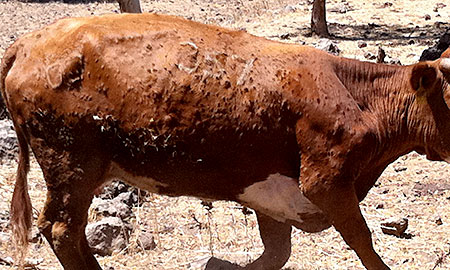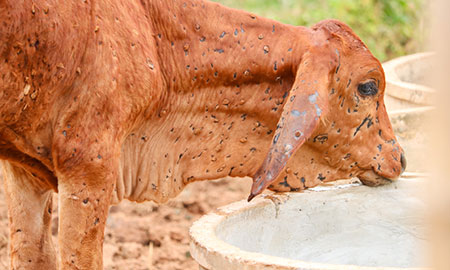Livestock producers across Australia must be alert for signs of lumpy skin disease (LSD) in their animals. LSD is a nationally notifiable disease and you MUST report any suspected signs immediately to the Emergency Animal Disease hotline on 1800 675 888. Save this hotline number in your phone. All suspected cases of LSD will be investigated by a veterinarian in your state or territory.
Don't hesitate to report. Our best chance to contain and eradicate LSD will rely on early detection and reporting. A false alarm is better than disease going undetected.
Clinical signs of LSD
The Outbreak website has advice on what to do if you suspect an emergency animal disease in your animals.
Producers and livestock workers should be aware of the signs of LSD in cattle and buffalo:
- Firm, raised nodules or lumps up to 5 cm in diameter can develop on any part of the body. They are often on the skin around the head, neck, genitals and limbs.
- The centre of the nodule dies, after which the resultant scabs may fall out, leaving large holes in the skin, that may become infected.
- Swelling of the limbs, brisket, genitals and lymph nodes may occur.
- Watering eyes.
- Increased nasal and salivary secretions.
- Loss of appetite and reluctance to move.
Some animals with the disease may not show signs.
Find out more about lumpy skin disease
Disease risk to northern Australia
Australia’s north is particularly vulnerable to LSD because the disease can spread through biting flies, mosquitoes and ticks.
People residing or working across Australia’s north, including cattle and buffalo producers, vets, hunters and local Indigenous communities, must be vigilant for LSD and aware of biosecurity requirements.
- Do not move live animals, meat and dairy products, untanned hides or skins, other animal products or soil between the Torres Strait Protected Zone and the Torres Strait Permanent Biosecurity Monitoring Zone, or to mainland Australia without a permit and an inspection by a Department of Agriculture, Fisheries and Forestry biosecurity officer.
- Keep a watch for planes or boats in your region that may be carrying animals or animal products onboard.
- Look out for food and garbage washed up on the beach that could carry pests or disease.
If you see any of these threats, contact a local ranger, your nearest Northern Australia Quarantine Strategy office or call the Emergency Animal Disease Hotline on 1800 675 888.
How producers can protect their livestock
LSD and foot-and-mouth disease are in our region, so all livestock producers should have measures in place to prevent and prepare for an exotic animal disease incursion.
If you don’t have a farm biosecurity plan, now is the time to prepare one. The Farm Biosecurity website has free resources to help you defend your property against diseases, pests and weeds. Use the links below to get started:
Further information
See what the government is doing to prevent an LSD incursion in Australia.


